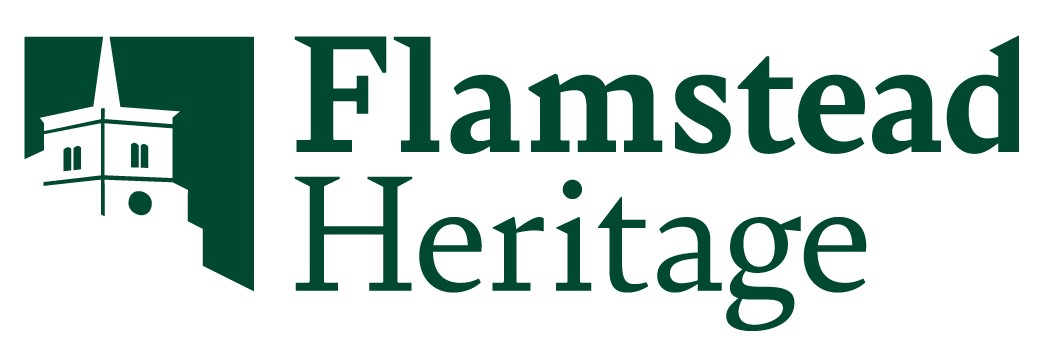Visitors to St Leonard’s Church during Flamstead’s Autumn Fayre will have encountered a scarecrow group of 13th century stonemasons busy going about the task of widening the building – and encouraging the 21st century onlookers to lend a hand! This tableau was part of three heritage activities being trialled in preparation for our second-round bid to the National Heritage Lottery Fund to repair the Church, and if the public reaction was anything to go by, it was a great success. Children – and adults too – dressed in period costume to join the scarecrow band, guiding a stone block being hoisted up the scaffolding, or filling a barrow with straw.

Visitors helping the heritage scarecrows
The scarecrows were created by local residents Pam and Hartley Dean, expert participants in the Flamstead Scarecrow Festival over many years, often being voted winners by the visiting public. Assisting them with this task were Tim and Ali Moss who helped with the background research, and expert re-enactors Annie and Bryan Thompson worked diligently to create the medieval costumes which transported participants 800 years back in time.
As well as the stone masons, life-size models of Sir Ralph deTony, Lord of Flamstead in 1220 and Hugh of Wells, Bishop of Lincoln, who granted St Leonard’s its Parish Church status in 1223 welcomed visitors to the Fayre and provided some historic background on the way that the church grew in size and status as indeed did Flamstead as a community. It was even granted the right to hold a market and a fair in medieval times.
Local resident Mark Evans researched and engineered an authentic-looking medieval wooden scaffold which towered 20ft into the air, using locally sourced wood. Seeing such realistic and impressive recreations helps immensely with children’s learning. In our recent consultation with audiences, local teachers told us if children can visit a historic location and see and touch things, it brings it all to life far more powerfully than lessons in class. Providing this kind of hands-on fun is a core aim of our heritage project “Living Histories, Lasting Journeys”.
The scarecrow exhibit was really popular, with a constant stream lining up to have a try. While watching, the visitors saw an informative slide-show explaining how the building has evolved over the nine centuries since it was built, from a much lower and shorter profile to the extensive space it now occupies, signalling its importance to the Lords of the Manor in years gone by.

Visitors enjoy solving the heritage quiz
Also popular with visitors young and old were the heritage trail quizzes – a fascinating trail of discovery for grown-ups, revealing the hidden heritage treasures of the building. Children enjoyed searching for church mouse doors, each associated with a clue. Filling in the correct answers on the quiz sheet earned a small prize.
Created by Miranda and Chris Motley, the heritage quiz is a favourite among people who aren’t familiar with the building, and is also a constant source of learning with people who know it well. New questions and fascinating facts appear each time a quiz is organised, each carefully researched from the huge repository of information about the building. Eric Edwards, a local historian, published “A New History of Flamstead” in 1999 but is even rumoured to be considering another edition.

Impressive puppets created by local particpants
The third heritage exhibit introduced people to the Young People’s Puppet Theatre, based in St Albans. The theatre does what it say on the tin – working with schools, a rewarding art, craft and drama project is created in which children learn how to build and operate the puppets, create the scenery, backdrops and furniture, run the stage and lighting, and provide narration during performances.
Jeremy Duschenes, the founder and executive director of the YPPT, is working closely with the Flamstead Heritage Project to design an approach in which puppets are used to tell the heritage stories of the colourful characters associated with the church in centuries gone by. Scripts will be created based on research by local enthusiasts, for projects with local schools.
All of these activities are examples of the kinds of hands-on fun engagement with history and heritage which we will be proposing to the National Lottery Heritage fund when we submit our second round bid for funding to save the church. We are immensely grateful to all National Lottery players who make this kind of funding possible: maintain and repairing a Grade I listed building is never cheap, and in our case the attack on the roof timbers by deathwatch beetle has escalated costs to the point where a small community simply cannot raise sufficient through the normal fundraising activities and local funds and trusts. In those cases, National Lottery through its heritage fund is a lifeline to keeping heritage alive and challenging bidders to make it relevant to many more people through imaginative ideas which bring it to life.
